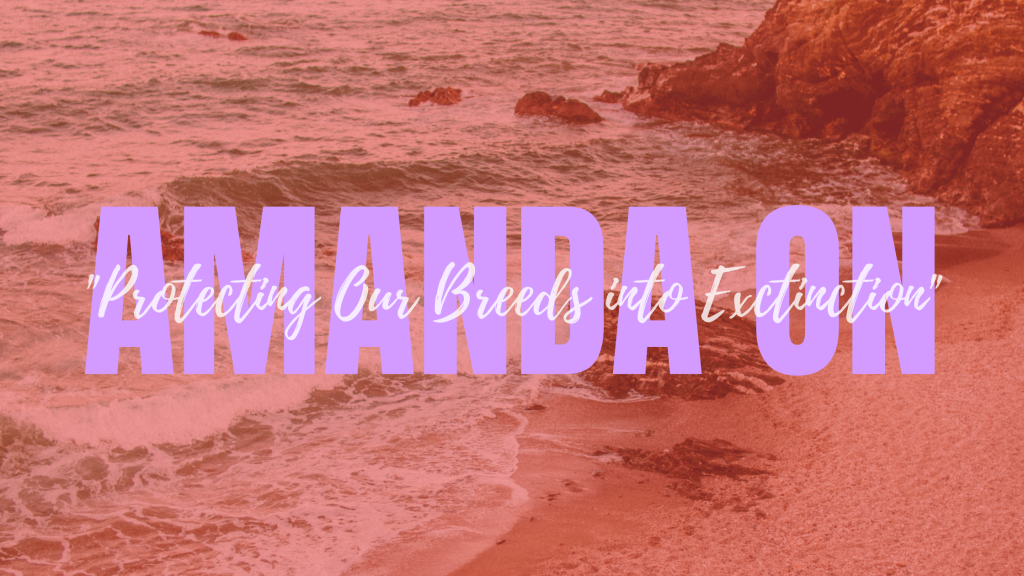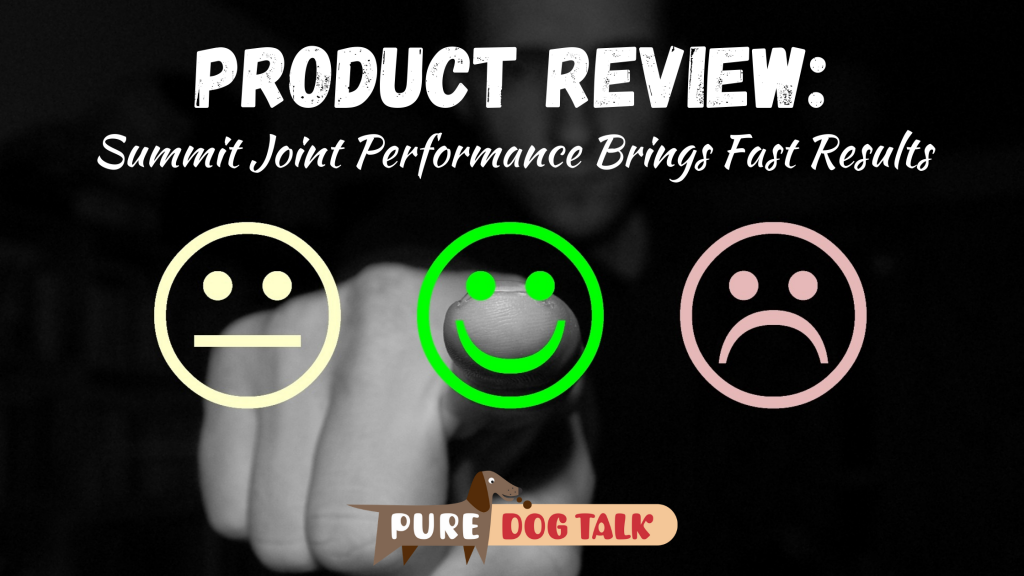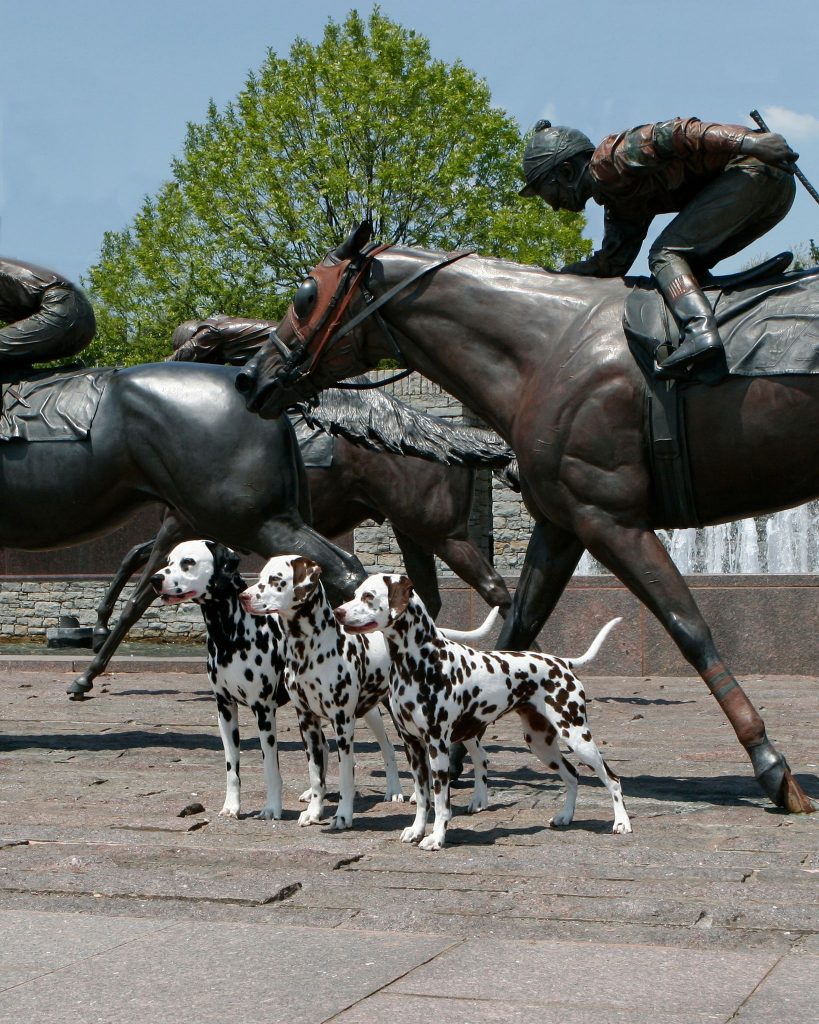436 – 10 Tips to Ease Your Journey in the Dog Show World
435 – Hot Topic: Are we “protecting our breeds into extinction”?
434 – Bill McFadden on Dog Shows During Covid: Safety First
Bill McFadden on Dog Shows During COVID: Safety First and Other Observations
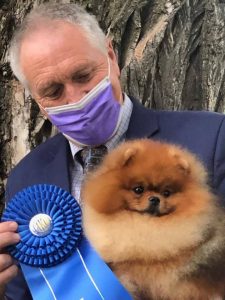 Professional handler Bill McFadden has attended shows across the country in the four months since the “Learning Cluster” in Oklahoma. A two-time Westminster Kennel Club BIS winning handler, lifetime participant in the sport and all-around good guy, McFadden’s observations, notes on what worked and self-appointed “bathroom police” stories provide a glimpse into this unprecedented time in American history.
Professional handler Bill McFadden has attended shows across the country in the four months since the “Learning Cluster” in Oklahoma. A two-time Westminster Kennel Club BIS winning handler, lifetime participant in the sport and all-around good guy, McFadden’s observations, notes on what worked and self-appointed “bathroom police” stories provide a glimpse into this unprecedented time in American history.
“My overview would be that I am proud of our community,” McFadden said. “I think that they’ve stepped up and either endured or participated in whatever protocol was established for each show. I hope it continues that way. I hope that we continue to be safe. I hope we get through this and maybe learn a few things about ourselves and our sport in the process.”
Host Laura Reeves commented that the silver lining of the year’s trying times is that we can “apply lessons from what we’re provided by the universe. You don’t get to pick (the circumstances) but you can pick how you respond to it.”
“Everybody just be safe and set your own limits for what you will or will not tolerate and stick to it,” McFadden added. “I actually have been impressed by people that step outside their comfort zone and say ‘you know, you’re standing too close.’ Some of the shows, the stewards actually will come up and say ‘could you guys spread out,’ ’cause we all kind of congregate during the groups. You kind of hang out while everybody else is being gone over. Old habits die hard. It wasn’t being defiant, it’s just you need someone to remind you.
“So, I’ve been really impressed by those actions by individuals and by clubs. Some of them do it in the most unbelievably gentle and kind way where you’re just like ‘oh gosh I’m so sorry’ … every once in a while there will be someone that’s a little snarky, but for the most part I think people have been doing a really good job.
“I will admit that I was nervous as I drove 24 hours to Oklahoma … I think everybody was. I know my assistant was. I was pleasantly surprised. Personally, I just thought that there might be a few resistant people that wouldn’t want to follow the rules that were set up. I was super impressed. I thought everybody complied. It’s definitely different showing with a mask on.
“…(P)articularly in the beginning, with the first few shows, we were just so happy to see each other. A lot of us hadn’t communicated so we weren’t really sure how our lives had gone and how are you surviving … initially I think there was a lot of that. I mean it was like going to a family reunion. We were just was so happy to see people … as it’s progressed, there’s people that we’ve seen several times, so it doesn’t feel like you’ve been away for so long.
“But I really think most people are just… we’re all in it together. We’re enduring it. We know we’re going to get through it and we’re helping each other out as much as we can. If there is one downfall, it’s really hard to control the social distancing after the show…”
Listen in as McFadden covers hotels, airplanes, COVID testing and more.
433 — Five Tips for Staying Motivated During Uncertainty
433 – Product Review: Summit Joint Performance Brings Fast Results
Product Review: Summit Joint Performance Brings Fast Results
Host Laura Reeves visits with Dorian Farmer and Rhonda Arza talk about Summit Joint Performance. This is a chondroitin product, used for years in Olympic horse circles, but now available for dogs and, hopefully, humans in the near future.
“This particular product was actually made to go into eyes, human eyes, during corneal lens transplant surgeries as an anti-inflammatory,” Summit Joint Performance founder Farmer said.
From the Summit Joint Performance website:
What is Summit?
- Summit is simply chondroitin 4 sulfate (C4S), suspended in sterile water. Summit was originally developed to use in human ocular lens transplant surgeries. Summit is the purest form of C4S available. Unlike other products, it has had all heparins and other potentially damaging molecules removed from the single C4S molecule. Summit is an all-natural product, not a synthetic created in the lab, nor polysulfated. Summit has an incredibly low molecular weight, and its small size allows it to penetrate barriers in the body, like joint capsules, much easier than other products. A large percentage of the molecules that make up tissues in the joints is C4S. Replenishing these structures with nature’s version of this important molecule, instead of synthetic lab creations that are over 100x the molecular weight, is of great benefit.
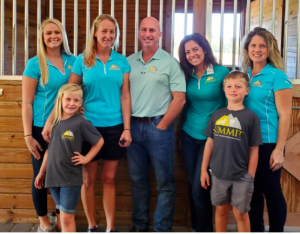
Dorian Farmer and the SJP team.
Farmer’s story of testing Summit on his personal “guinea pig” animals is inspiring.
“We injected Ultra on a Wednesday evening. At that point in time she couldn’t get up off the ground. By Thursday morning when we woke up, she was standing in our bedroom wagging her tail looking at me. She had got up off the ground by herself, into the bedroom and was waking us up. She could walk around the house. She could sit down. She could lay down and she could get back up. That was within 12 hours. By the following day she was trotting around the house and actually playing with me.
“(A couple days later I got a video of) Ultra chasing the golf cart at a dead run from the back pasture to the front pasture. It’s about 900 yards from one to the other. She lived for another year pain free because of it. That truly was the point where I knew that we had something that was incredible. She had been on all the pain relievers and all the other arthritic medication and everything else and nothing was touching it. One shot of this new product and saved her life. I mean, we were going to euthanize her….”
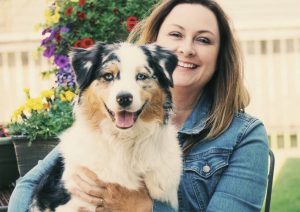
Rhonda Arza, SJP Vice President
Arza, Summit Joint Performance Vice President, shared her similar experience.
“I was a horse trainer for 28 years and one of the things that I knew was that I didn’t want to be a horse trainer for 29 years. So, I needed an exit strategy. Summit last November became a direct sales company. I had experience in the field, so I knew that direct sales was a way to make significant income and create an exit strategy not only for myself, but for other trainers who were looking to retire, get out, whatever they needed to do.
“When this came along, because of the level of sponsored riders that this company already had in place, like people were putting it in their $10,000,000 Olympic level horses, we had guys like McLain Ward (using the product), I knew that we had a product that was definitely something that I could talk about.
“I put it into my 20-year-old jumper and he just turned right around and acted like he was ten. I wanted to get into the dog space because we have performance dogs. My husband shows in rally and obedience and we have Australian Shepherds. Knowing that it was going to be turning over to oral (versus intramuscular injection) was going to open up the whole planet for us. Not only dog show people, but pet owners and people who have older cats and things like that.
“This is going to not only change the lives of so many pets, it’s going to change the lives of so many humans. Especially during this time frame where we’re not going to as many horse shows, we’re not going to as many dog shows, we’re in a little bit of a financial pickle. This is the answer to people’s prayers.”
“We all take glucosamine chondroitin supplements that we get in the grocery store,” Farmer noted. “They say ‘in six months you should start to see some results.’ I don’t do anything for six days if I don’t see results. I am a very instant gratification, transactional kind of guy. I’m going to do this, I expect to see results. That was what we saw with this. I didn’t have to wait six weeks or a month or two weeks, we saw results the next day.”
432 — Infertility in Dogs: Regular, Random and Rare Causes
Infertility Issues: Regular, Random and Rare Causes
Dr. Marty Greer, DVM joins host Laura Reeves for a wide-ranging conversation on the causes of infertility in our breeding bitches. From split seasons, ovarian and uterine cysts, to semen allergy and genetic incompatibility, we cover a lot of ground.
Marty was kind enough to provide the following “check list” of fertility issues to share with our listeners. Links to previous Pure Dog Talk podcasts on the topics noted are included in the underlined areas.
Why isn’t my female pregnant? What can I do about it?
by Dr. Marty Greer, DVM
You did your homework – and have the perfect bitch, in her best condition and found the ideal male to mate her to. Both of them have passed all of the health clearances recommended for your breed. They have the temperaments you are looking for and their traits are complimentary to one another.
You know the most common causes of apparent or actual pregnancy failure are:
- Poorly timed breedings
- Poor semen quality and/or quantity.
- Failure to maintain a pregnancy
Timing the breeding:
The timing of the breeding, based on progesterone levels (bred 2 to 3 days post-ovulation depending on semen type used), was just right. Most veterinarians recommend breeding 2 days after ovulation with fresh and fresh chilled shipped semen and 3 days with frozen semen. Ovulation is assumed to occur when the progesterone reaches 5 ng/dl (different units are used in other countries) with a range of 4 to 10 ng/dl. LH testing is also done in some clinics. LH, Luteinizing hormone, directly indicates ovulation, while progesterone is an estimation of ovulation. Progesterone is easier to measure and test as it can be done every few days, using human technology. LH requires daily testing and is canine specific.
Semen quality and quantity:
You know the stud dog had good quality and quantity semen – there was a semen analysis completed prior to shipping the semen. Your vet looked at it prior to inseminating your bitch and said the semen looked great, based on the sperm count (for a Bernese Mountain dog, the count should be 1 billion total), the morphology (shape and appearance of each sperm cell) and motility (how active and progressively motile it was on a microscopic evaluation).
Yet, she is not pregnant. Why? And if you try to breed her again, what can you do differently to improve the chances she will carry a litter to term?
First, we need to determine if she failed to conceive, failed to achieve fetal/placental implantation, or conceived and lost the litter. If you don’t have her ultrasounded, you won’t know if she failed to conceive or failed to maintain the pregnancy. A relaxin test or palpation is not adequate – these do not assess for fetal viability. This information is big piece of the puzzle. When you are trying to justify the decision to do an ultrasound, this is the best reason to do so – this is not the place to scrimp.
If the ultrasound shows no pregnancy, and the semen and timing were good, then causes for failure to conceive or failure for fetuses to implant should be explored. These include:
- Was there a Semen quality assessment?
- Was the sperm count low?
- Was there abnormal semen morphology? Was the semen stained and assessed by a veterinarian?
- Was there poor semen motility? The semen needs to be progressively normal.
- Was there poor semen longevity? Holding a small sample of semen in extended in the refrigerator and reassessing it 24 and 48 hours later can be useful.
- Was there timing failure? This is a good time to review the timing of the breeding.
- Did she complete her ovulation?
- Failure to complete the ovulation. Did the progesterone testing continue past 5 ng/dl? If not, she may have not had a complete ovulatory cycle.
- Cystic ovaries? An ovarian cyst can interfere with a complete ovulatory cycle.
- Split cycle? If she failed to complete her ovulation, she may have split her cycle and will come back into heat in the next 4 to 6 weeks.
- Failure of adequate semen deposition: Fertile sperm must reach a fertile egg.
- If this was a natural breeding, was there a tie? Was the breeding witnessed? Was there a normal length tie?
- If this was a vaginal AI, was the AI performed correctly with no spermicidal exposure. Some lubricants and reusable equipment can have spermicidal properties. Using all disposable supplies is recommended.
- Does the bitch have a defect in her reproductive tract? Structural abnormalities causing failure of semen passage from the vagina to the oviducts including male and female anatomical abnormalities.
- Do either the male or female have Brucellosis? Canine brucellosis is a bacterial disease that can be spread venerally and can cause sterility in the male or female as well as pregnancy failure and early neonatal death.
- Was the bitch exposed to Canine Herpesvirus? – This is a viral disease that can cause early or late fetal death as well as neonatal death. In the adult, Canine Herpervirus causes mild respiratory disease. During early pregnancy, the fetuses can die at any stage, causing apparent failure to conceive if it is contracted during early pregnancy.
- Does the bitch have a bacterial infection in the vagina or uterus? A low-grade metritis, not rising to the level of a pyometra can interfere with conception. The difficulty here is that even in 2017, we cannot identify what normal bacterial flora in the reproductive tract is.
- Did she have another bacterial or viral disease that are not yet well characterized?
- Does she have a systemic illness? Any disorder that causes a fever can interrupt a pregnancy. Did she have a complete blood panel test, checking for signs of infection or organ disease? Consider testing for Lyme disease, Anaplasmosis, and Ehrlichia before you breed.
- Failure of the ovary to maintain progesterone high enough to support pregnancy (hypoluteoidism) Rarely, a bitch will have the inability to keep her progesterone level high enough to maintain pregnancy. This can occur as early as day 14 of the pregnancy. Testing her progesterone level at her pregnancy ultrasound can be an important tool.
- Does the bitch have abnormalities in her uterine lining? Cystic endometrial hyperplasia and fibrosis of the uterus can prevent normal placental development.
- Is there genetic incompatibility? If there are fatal genes, conception with pregnancy failure can occur. Line breeding dogs with too little genetic diversity can lead to small or no litters.
- Was there inadequate maternal nutrition?
- Raw meat diets can contribute to an imbalanced nutritional plane. Micronutrients and macronutrients must be adequate to maintain pregnancy. Bitches require carbohydrates to maintain pregnancy as well as to lactate.
- Does she have parasites? Parasite migration can lead to placental failure. The stress of pregnancy can lead to latent parasites starting to migrate again. Using Fenbendazole from day 40 of pregnancy to day 14 of lactation can protect the fetuses from this condition.
- Was the bitch subjected to trauma? Blunt trauma can cause the placentas to fail.
- Was the bitch subjected to undue stress?
- Did the bitch receive anesthesia, or inappropriate drug or hormones? Many of these drugs can be toxic to developing fetuses. All drugs should be avoided during pregnancy unless required to save the bitch’s life.
- Is the bitch Hypothyroid? Low thyroid levels can contribute to pregnancy failure or failure to conceive. This is a rare cause of pregnancy failure but should be considered if the levels are profoundly low.
If no underlying cause for failure to conceive is found, surgical breeding may be considered to improve the chances of success at the next breeding. Some bitches will conceive pups when surgical breedings are used to deliver the semen directly into the uterine body.
If the ultrasound shows a pregnancy was achieved but not maintained, this can result in fetal resorption (prior to day 45 of pregnancy) or fetal death and/or abortion (fetal loss after day 45 of pregnancy). This rules out poor timing, poor semen quality, or failure of semen to pass to the oviducts as causes for infertility.
Causes of failure to maintain a pregnancy include (see descriptions above):
- Brucellosis?
- Herpesvirus?
- Bacterial infections in the uterus. Cultures should be taken and antibiotics used if bacterial disease is suspected.
- Other bacterial and viral diseases that are not yet well characterized.
- Failure of the ovary to maintain progesterone high enough to support pregnancy (hypoluteoidism). Serial progesterone levels should be run if hypoluteoidism is suspected.
- Uterine lining changes that interfere with maintained placental attachment.
- Inadequate maternal nutrition.
- Trauma, stress, anesthesia or drug and hormonal interference.
A complete history should be taken. Diagnostics should include testing for brucellosis and Canine Herpesvirus. Cornell’s Veterinary Diagnostic lab has a blood profile called the “Canine Abortion Panel. Your veterinary clinic can submit tests for this. It is best done with paired samples, drawn 3 weeks apart and submitted together.
The pregnancy can be monitored for viable fetuses with repeated ultrasounds. WhelpwiseTM can be used to manage high risk pregnancies. Antibiotics, progesterone and terbutaline may be indicated if uterine irritability is shown to be putting the pups at risk. These drugs help quiet the uterus and can keep the pups safely in the uterus until they reach full term.
431 – Dalmatians: the “Brilliant, Spotted, Energized” Dogs of Croatia
Dalmatians: the “Brilliant, Spotted, Energized” Dogs of Croatia
Dalmatians are our Love the Breeds topic today with enthusiasts Meg Callea, Molly Spengler and Stephanie Podejko joining host Laura Reeves for a timely conversation ahead of the release of the “101 Dalmatians” remake.
History
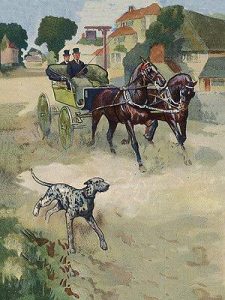
Historic illustrations of Dalmatians accompanying coaches.
“Dalmatians have kind of … a mixed historical background,” Callea noted. “There are spotted dogs on tombs in Egypt, on frescoes in Italy… theoretically they were started in Dalmatia … which is a historic province of Croatia. They were developed to be basically a dog to go with horses and a guard dog. They were to guard the horses and guard the stables. While they were in the stables, (a) desired trait was to kill vermin. So they do that really well. They have a lot of prey drive, some of them have a lot more than they need, which is why they do really well at some of the other performance events.
Dalmatian competing in tracking event.
“There are illustrations of Dalmatians as far back as the 1600s. They were brought into being a breed more in the early 1800s, during the Regency period, where they were bred for their markings to look real fancy with the carriages and coaches. They were bred to run around and go with the carriage all day long, so that’s somewhere between 25 to 40 miles a day. Their job was to alert the carriage people if there was a bad guy around, to chase off rogue dogs or Wolves, and to protect the carriage and its contents. And to keep the horses company, because the horses that ran were pretty high strung. Which is how they came into being with the fire Department.

Dalmatians are iconic symbols for fire departments world wide.
“The fire Department used to have carriages that were horse drawn. The horses that drew those things were really high spirited, so the dogs kept them company while they were sitting around waiting for something to happen. When something happened, they ran with the horses, they broke up the traffic in front of them. They also kept the horses calm at the fire because horses do not like fire. They also protected the water spigot. Potable, drinkable water was hard to come by, so while the guys were fighting a fire somebody would come in to disconnect their hose and steal the water.”
Coaching Competition and Performance Events

Dalmatians excel in all performance events, according to our panelists.
“This is a breed that can do it all,” Podejko said. “There isn’t a sport out there that I have found, a performance sport, that Dalmatians don’t excel at. They’re just a brilliant breed.”
The Dalmatian Club of America features a breed specific test and competition called a Road Trial. The most advanced level requires the dogs, horses and riders to cover 25 miles in an endurance competition. According to Podejko, “A Dalmatian Road Trial is a performance event and test in the field designed to evaluate the Dalmatian’s ability to “coach,” or follow the horses. Exhibitors compete as handler on horseback or in a horse-drawn cart or carriage, with dog(s) off-leash. The Dalmatian Standard of the American Kennel Club states that the Dalmatian “should be capable of great endurance, combined with a fair amount of speed,” qualities essential to his successful use as a horse/rider and horse/coach escort. The purpose of a Road Trial is to demonstrate the use of purebred Dalmatians as a companion of man in the role that they have been bred to perform.”
Health and longevity

Breed specific health concerns have been mitigated by conscientious breeders testing their dogs.
Spengler shared information on breed specific kidney stones and how to manage them with appropriate diet. Our panelists also discussed the success of preservation breeders testing for and drastically reducing the number of dogs produced with deafness issues and how that was managed.
“It’s very important to do your research (when considering purchasing a Dalmatian) because there are some key things that go along with the breed,” Spengler advised.
Panelists:
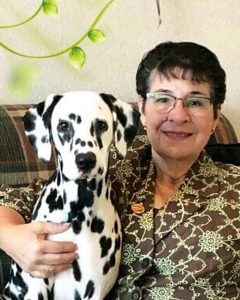
Meg Callea
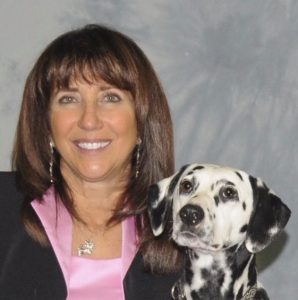
Stephanie Podejko
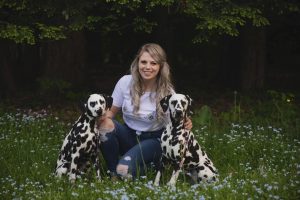
Molly Spengler


